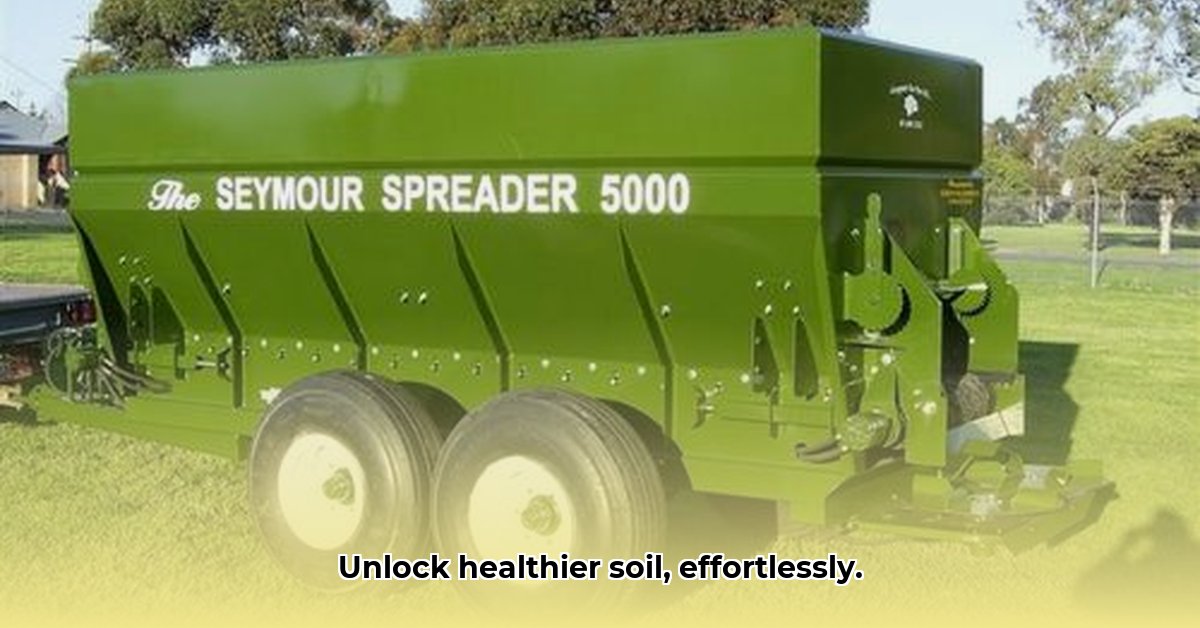
Choosing the right compost spreader tractor can significantly enhance soil health and boost yields, whether you're a seasoned farmer or a home gardener. This comprehensive guide will help you navigate the various options, optimize your operation, and understand the return on investment. For more information on compost spreaders for tractors, check out this helpful resource.
Understanding Your Compost Spreader Tractor Options
Earth & Turf offers a range of compost spreader tractors to suit diverse needs and scales of operation. Selecting the right model depends on the size of your project, the type of compost you're using, and your budget. Let's explore the key differences:
Tow-Behind Models: Ideal for smaller areas like home gardens or supplementing larger operations. These are generally more affordable and easy to maneuver, making them perfect for those with limited space or budgets. Think of them as the compact cars of the compost world – efficient and easy to handle.
Self-Propelled Models: Designed for larger areas and heavier workloads, such as farms, golf courses, or extensive landscaping projects. They offer increased efficiency and capacity, but come with a higher initial investment. These are the workhorses, capable of tackling large-scale projects with ease.
Capacity Considerations: Compost spreaders come with varying hopper sizes (the container holding the compost). Larger hoppers reduce refill frequency but increase the overall size and cost of the machine. Consider your project’s scale and how often you’re comfortable refilling. A larger hopper might sound appealing, but is it truly necessary for your needs?
| Model Type | Ideal Use Cases | Capacity (Example) | Pros | Cons |
|---|---|---|---|---|
| Tow-Behind | Home gardens, small landscaping, supplemental use | 2-4 cubic yards | Affordable, easy to maneuver, simple operation, low maintenance | Limited capacity, requires a separate towing vehicle |
| Self-Propelled | Farms, golf courses, large properties | 10+ cubic yards | High capacity, efficient, independent operation, covers large areas quickly | Higher initial cost, potentially more complex maintenance, higher fuel use |
Selecting the Right Compost Spreader Tractor
Choosing the perfect compost spreader involves careful consideration of your specific needs. Here's a structured approach to help you make the right decision:
Assess Land Area: How much land do you need to cover? A small garden requires a different machine than a large farm.
Compost Type: The consistency of your compost (dry, wet, clumpy) affects spreader selection. Some spreaders handle heavier materials more effectively. Does your compost tend to be fluffy, or more dense and moist?
Budget Analysis: Consider both the initial purchase price and ongoing operational costs (fuel, maintenance, repairs). A higher upfront cost might lead to significant savings in the long run via increased efficiency. How will this investment impact your overall budget?
Consider ROI: Will this investment lead to increased yields, reduced labor costs, or the ability to take on more projects? How will you track and calculate your return on investment?
Operating Your Compost Spreader Tractor: Safety and Efficiency
Safe and efficient operation is paramount. Follow these guidelines for optimal results and to minimize potential risks:
Assembly: Carefully follow the manufacturer's instructions. A rushed assembly can lead to malfunctions or safety hazards.
Calibration: Before spreading, calibrate the spreader based on your compost type and the desired spread width. Practice in a small area to get comfortable with the controls and spreader pattern.
Operation: Always operate on level ground and adhere strictly to safety guidelines outlined in the operator's manual.
Maintenance: Regular maintenance, such as cleaning the hopper, lubricating moving parts, and inspecting for wear and tear, is crucial for longevity and optimal performance. Preventative maintenance saves money in the long run, similar to maintaining a vehicle. How often will you perform routine maintenance checks?
Safety Precautions: Always wear appropriate safety gear (eye protection, gloves). Keep children and pets away from the operating area. Never operate heavy machinery when tired or distracted. Are you familiar with all applicable safety regulations concerning this type of equipment?
Cost Considerations and Return on Investment (ROI)
The initial investment in a compost spreader includes the purchase price, attachments, and delivery. Ongoing costs include fuel (for self-propelled models), maintenance, and potential repairs. However, the return on investment can be substantial:
Reduced Labor Costs: The spreader significantly reduces the time and effort required for manual spreading.
Increased Yields: Improved soil health often translates to healthier plants and higher yields, resulting in increased revenue.
Environmental Benefits: The use of compost reduces reliance on chemical fertilizers, contributing to more sustainable farming practices.
Calculating the ROI requires a thorough assessment of these factors. Consider factors including the cost of labor saved, any increase in yield or income, and the lifespan of the spreader. Would a higher-priced, longer-lasting model be a better investment in the long term?
Case Study: Real-World Success with Earth & Turf Spreaders (if available)
(Insert a case study here illustrating how an Earth & Turf compost spreader has helped a user achieve improvements in soil health, increased efficiency, or enhanced profitability. Include details about the specific model used, the user's experience, and quantifiable results.)
Remember, investing in the right compost spreader tractor is an investment in the long-term health of your soil and the success of your operation. By carefully considering your needs and following proper safety procedures, you can maximize the benefits and achieve a strong return on your investment.